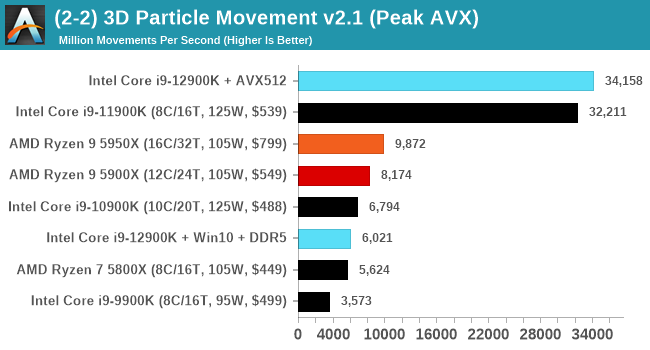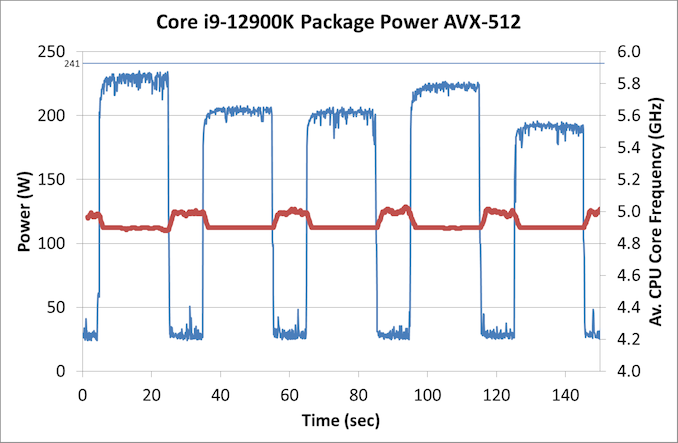The Intel 12th Gen Core i9-12900K Review: Hybrid Performance Brings Hybrid Complexity
by Dr. Ian Cutress & Andrei Frumusanu on November 4, 2021 9:00 AM ESTIntel Disabled AVX-512, but Not Really
One of the more interesting disclosures about Alder Lake earlier this year is that the processor would not have Intel’s latest 512-bit vector extensions, AVX-512, despite the company making a big song and dance about how it was working with software developers to optimize for it, why it was in their laptop chips, and how no transistor should be left behind. One of the issues was that the processor, inside the silicon, actually did have the AVX-512 unit there. We were told as part of the extra Architecture Day Q&A that it would be fused off, and the plan was for all Alder Lake CPUs to have it fused off.
Part of the issue of AVX-512 support on Alder Lake was that only the P-cores have the feature in the design, and the E-cores do not. One of the downsides of most operating system design is that when a new program starts, there’s no way to accurately determine which core it will be placed on, or if the code will take a path that includes AVX-512. So if, naively, AVX-512 code was run on a processor that did not understand it, like an E-core, it would cause a critical error, which could cause the system to crash. Experts in the area have pointed out that technically the chip could be designed to catch the error and hand off the thread to the right core, but Intel hasn’t done this here as it adds complexity. By disabling AVX-512 in Alder Lake, it means that both the P-cores and the E-cores have a unified common instruction set, and they can both run all software supported on either.
There was a thought that if Intel were to release a version of Alder Lake with P-cores only, or if a system had all the E-cores disabled, there might be an option to have AVX-512. Intel shot down that concept almost immediately, saying very succinctly that no Alder Lake CPU would support AVX-512.
Nonetheless, we test to see if it is actually fused off.
On my first system, the MSI motherboard, I could easily disable the E-cores. That was no problem, just adjust the BIOS to zero E-cores. However this wasn’t sufficient, as AVX-512 was still clearly not detected.
On a second system, an ASUS motherboard, there was some funny option in the BIOS.
Well I’ll be a monkey’s uncle. There’s an option, right there, front and centre for AVX-512. So we disable the E-cores and enable this option. We have AVX-512 support.
For those that have some insight into AVX-512 might be aware that there are a couple of dozen different versions/add-ons of AVX-512. We confirmed that the P-cores in Alder Lake have:
- AVX512-F / F_X64
- AVX512-DQ / DQ_X64
- AVX512-CD
- AVX512-BW / BW_X64
- AVX512-VL / VLBW / VLDQ / VL_IFMA / VL_VBMI / VL_VNNI
- AVX512_VNNI
- AVX512_VBMI / VBMI2
- AVX512_IFMA
- AVX512_BITALG
- AVX512_VAES
- AVX512_VPCLMULQDQ
- AVX512_GFNI
- AVX512_BF16
- AVX512_VP2INTERSECT
- AVX512_FP16
This is, essentially, the full Sapphire Rapids AVX-512 support. That makes sense, given that this is the same core that’s meant to be in Sapphire Rapids (albeit with cache changes). The core also supports dual AVX-512 ports, as we’re detecting a throughput of 2 per cycle on 512-bit add/subtracts.
For performance, I’m using our trusty 3DPMAVX benchmark here, and compared to the previous generation Rocket Lake (which did have AVX-512), the score increases by a few percent in a scenario which isn’t DRAM limited.

Now back in that Rocket Lake review, we noted that the highest power consumption observed for the chip was during AVX-512 operation. At that time, our testing showcased a big +50W jump between AVX2 and AVX-512 workloads. This time around however, Intel has managed to adjust the power requirements for AVX-512, and in our testing they were very reasonable:
In this graph, we’re showing each of the 3DPM algorithms running for 20 seconds, then idling for 10 seconds. Each one has a different intensity of AVX-512, hence why the power is up and down. IN each instance, the CPU used an all-core turbo frequency of 4.9 GHz, in line with non-AVX code, and our peak power observed is actually 233 W, well below the 241 W rated for processor turbo.
Why?
So the question then refocuses back on Intel. Why was AVX-512 support for Alder Lake dropped, and why were we told that it is fused off, when clearly it isn’t?
Based on a variety of conversations with individuals I won’t name, it appears that the plan to have AVX-512 in Alder Lake was there from the beginning. It was working on early silicon, even as far as ES1/ES2 silicon, and was enabled in the firmware. Then for whatever reason, someone decided to remove that support from Intel’s Plan of Record (POR, the features list of the product).
By removing it from the POR, this means that the feature did not have to be validated for retail, which partly speeds up the binning and testing/validation process. As far as I understand it, the engineers working on the feature were livid. While all their hard work would be put to use on Sapphire Rapids, it still meant that Alder Lake would drop the feature and those that wanted to prepare for Alder Lake would have to remain on simulated support. Not only that, as we’ve seen since Architecture Day, it’s been a bit of a marketing headache. Whoever initiated that dropped support clearly didn’t think of how that messaging was going to down, or how they were going to spin it into a positive. For the record, removing support isn’t a positive, especially given how much hullaballoo it seems to have caused.
We’ve done some extensive research on what Intel has done in order to ‘disable’ AVX-512. It looks like that in the base firmware that Intel creates, there is an option to enable/disable the unit, as there probably is for a lot of other features. Intel then hands this base firmware to the vendors and they adjust it how they wish. As far as we understand, when the decision to drop AVX-512 from the POR was made, the option to enable/disable AVX-512 was obfuscated in the base firmware. The idea is that the motherboard vendors wouldn’t be able to change the option unless they specifically knew how to – the standard hook to change that option was gone.
However, some motherboard vendors have figured it out. In our discoveries, we have learned that this works on ASUS, GIGABYTE, and ASRock motherboards, however MSI motherboards do not have this option. It’s worth noting that all the motherboard vendors likely designed all of their boards on the premise that AVX-512 and its high current draw needs would be there, so when Intel cut it, it meant perhaps that some boards were over-engineered with a higher cost than needed. I bet a few weren’t happy.
Update: MSI reached out to me and have said they will have this feature in BIOS versions 1.11 and above. Some boards already have the BIOS available, the rest will follow shortly.
But AVX-512 is enabled, and we are now in a state of limbo on this. Clearly the unit isn’t fused off, it’s just been hidden. Some engineers are annoyed, but other smart engineers at the motherboard vendors figured it out. So what does Intel do from here?
First, Intel could put the hammer down and execute a scorched earth policy. Completely strip out the firmware for AVX-512, and dictate that future BIOS/UEFI releases on all motherboards going forward cannot have this option, lest the motherboard manufacturer face some sort of wrath / decrease in marketing discretionary funds / support. Any future CPUs coming out of the factory would actually have the unit fused out, rather than simply turned off.
Second, Intel could lift the lid, acknowledge that someone made an error, and state that they’re prepared to properly support it in future consumer chips with proper validation when in a P-core only mode. This includes the upcoming P-core only chips next year.
Third, treat it like overclocking. It is what it is, your mileage may vary, no guarantee of performance consistency, and any errata generated will not be fixed in future revisions.
As I’ve mentioned, apparently this decision didn’t go down to well. I’m still trying to find the name of the person/people who made this decision, and get their side of the story as to technically why this decision was made. We were told that ‘No Transistor Left Behind’, except these ones in that person’s mind, clearly.












474 Comments
View All Comments
mode_13h - Saturday, November 6, 2021 - link
On what basis do you reach that verdict? Based on your posts, I wouldn't trust you to run a corner shop, much less one of the biggest and most advanced tech & manufacturing companies on the planet.And where did they said it's "fused off"? AFAIK, all they said is that it's not available and this will not change. And we've seen no evidence of that being untrue.
Also, I think you're getting a bit too worked up over the messaging. In the grand scheme, that's not the decision that really matters.
SystemsBuilder - Saturday, November 6, 2021 - link
no I did no miss that. I'm just happy that ASUS found a way to enable it.Intel screwed up of course - battel between different departments and managers, marketing etc I'm sure - that's a given and did not think it was necessary to repeat that. And yes it is absurd - even incompetent.
Still I'm happy ASUS found it and exposed it, because, as I said they they actually seam to have gotten AVX-512 right in Golden cove.
Intel should of course work with Microsoft to get the scheduler to work with any E/P mix, make the support official, enable it in the base BIOS, have base BIOS sent over to all OEMs and lastly fire/reassign the idiot that took AVX-512 off the POR for Alder lake.
In any case it give me something to look forward to with Sapphire rapids which should come with more Golden cove P cores.
I only by ASUS boards so
SystemsBuilder - Saturday, November 6, 2021 - link
can't edit post so continuing:I only buy and use ASUS boards so for me it's fine but I sucks for others.
Also doubt that Pat was involved. Decisions were likely made before his arrival. I'm thinking about the Microsoft dependency. They would have needed to lock the POR towards Microsoft a while back to give MS enough time to get the scheduler and other stuff right...
Oxford Guy - Saturday, November 6, 2021 - link
The product was released on his watch, on these incompetent terms. Gelsinger is absolutely responsible. He now has a serious black mark on his leadership card. A competent CEO wouldn’t have allowed this situation to occur.This is an outstanding example of how the claim that only engineers make good CEOs for tech companies is suspect.
‘I only by ASUS boards so’
Lies of omission are lies.
SystemsBuilder - Saturday, November 6, 2021 - link
I totally agree that it goes against putting engineers in charge.for me the whole AVX-512 POR decision and "AVX-512 is fused off" message is coming out of a incompetent marketing department when they were still in charge.
Oxford Guy - Saturday, November 6, 2021 - link
‘when they were still in charge.’Gelsinger isn’t the CEO? Gelsinger wasn’t the CEO when Alder Lake was released? Marketeers outrank the CEO?
The buck stops with him.
The implication that having an engineer run a business makes said engineer a skilled businessperson is safely dead.
The success of Steve Jobs also problematized that claim well before this episode, as he was not an engineer.
SystemsBuilder - Saturday, November 6, 2021 - link
i think under the old "regime" marketing did out rank engineering so that the old CEO listened more to marketing than engineering (of course the CEO makes the decision but he takes input from various camps and that is what i mean with marketing "were still in charge"). A non-engineering educated CEO is particularly influenceable by marketing (especially if he/she has MBA with marketing specialization like the old CEO's). Hence the messaging decisions to "fuse it off" was likely heavily influenced by marketing who i think finally won over Engering. Pat had to inherit this decision but could not change i for windows 11 launch - it was too late.Oxford Guy - Saturday, November 6, 2021 - link
Of course he could change it. He’s the CEO.mode_13h - Saturday, November 6, 2021 - link
> so that the old CEO listened more to marketing than engineeringIn this case, the issue wouldn't be who the CEO listens to, but who gets to define the products. Again, the issue of AVX-512 in Alder Lake is something that would probably never rise to the attention of the CEO, in a company with $75B annual revenue, tens of thousands of employees at hundreds of sites, and many thousands of products in hundreds of different markets. OG apparently has no concept of what these CEOs deal with, on a day to day basis.
mode_13h - Saturday, November 6, 2021 - link
> Gelsinger wasn’t the CEO when Alder Lake was released?So what was he supposed to do? Do you think they run all PR material by the CEO? How would he have any time to make the important decisions, like about running the company and stuff?
It seems to me like you're just playing agent provocateur. I haven't even seen you make a good case for why this matters so much.